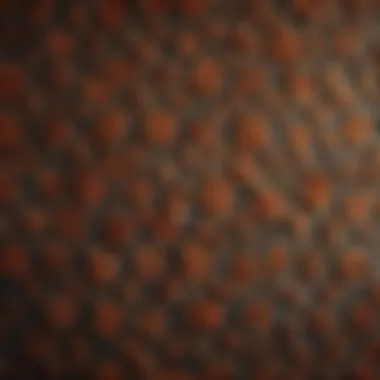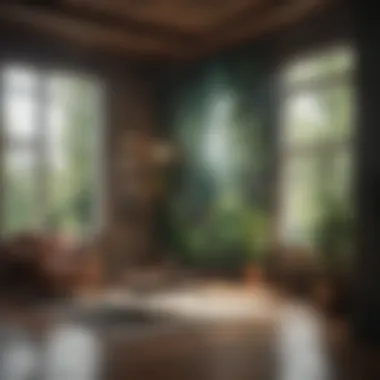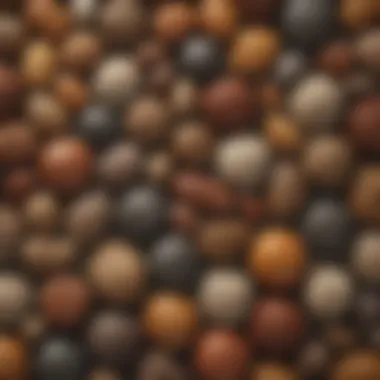Imported Wallpaper: Aesthetic Appeal and Practicality


Intro
Imported wallpaper serves as a canvas for cultural expression and functional design within interior spaces. The rise of global trade has made it possible for distinctive wallpapers to be sourced from different corners of the world, resulting in a rich tapestry of styles and materials. This article delves into the multifaceted nature of imported wallpaper by examining its aesthetic appeal, diverse materials, and practical applications. It also addresses the environmental concerns related to importing these wall coverings and reflects on the contemporary design trends shaping consumer choices today.
Cultural Significance
Influence on Interior Aesthetics
The role of wallpaper transcends mere coverage of walls; it unfolds stories through patterns, colors, and textures. Imported wallpaper often embodies the heritage and artistic sensibilities of its origin. For example, Japanese washi paper offers intricate designs that have historical significance, while Italian textiles present luxurious patterns that can transform an ordinary space into an elegant residence.
Symbolism in Design
Beyond mere decoration, imported wallpaper can serve as a symbol of cultural appreciation and global connectivity. Using materials from different countries can signify the homeowner's identity or aesthetic preferences.
Impact on Art
The influence of wallpaper on art is notable. Many artists draw inspiration from the designs found in various wallpapers, integrating these elements into their artworks. The interplay of patterns and colors in wallpaper can contribute to broader artistic movements and trends.
Home and Hearth
Wallpaper sometimes serves as a family narrative, displaying memories and themes that are intrinsic to a household's identity. Patterns linked to family traditions or cultural backgrounds can become focal points in living spaces.
Material Diversity
Eco-Friendly Options
With growing consciousness about sustainability, imported wallpaper includes a range of eco-friendly materials. Options like bamboo fiber and recycled paper bring both environmental sensitivity and aesthetic appeal. These materials are particularly relevant as consumers prioritize sustainable practices in their purchasing decisions.
Unique Textures and Finishes
The variety of textures available ensures that homeowners can find something that resonates with their design vision. Textures can range from smooth vinyl to textured grass cloth, each bringing unique tactile experiences to a room.
Quality of Craftsmanship
Imported wallpaper is often characterized by superior craftsmanship. High-quality materials result in enhanced durability, making these products a worthy investment. Wallpapers, such as those produced in France, are renowned for their meticulous production processes.
Installation Methods
Professional Assistance or DIY
When considering imported wallpaper, the installation method is crucial. While some opt for professional help, others may prefer a DIY approach. Understanding the specific requirements of different materials is essential when deciding which route to take.
Preparation Steps
Successful installation often requires thorough preparation. Key steps include measuring wall space, selecting the right adhesive, and ensuring a clean surface prior to application.
Maintenance Considerations
Maintenance varies by material. Imported wallpaper may require specific care to maintain its look and longevity. Factors to consider include resistance to moisture, cleaning methods, and the impact of sunlight.
In summary, imported wallpaper provides a rich array of aesthetic choices and practical applications, merging the cultural significance of global designs with modern interior needs.
Finale
Understanding the various dimensions of imported wallpaper allows consumers to appreciate its role in enhancing living spaces. From its cultural significance to material diversity and installation insights, it is a powerful tool in interior design. As trends evolve, the emphasis on eco-friendly choices makes this topic increasingly relevant. Whether one is renovating a home or seeking to refresh a space, careful consideration of imported wallpaper can elevate the aesthetic and functional attributes of any environment.
Prelims to Imported Wallpaper
Exploring imported wallpaper provides a unique lens through which we can examine trends, aesthetic choices, and functionality in interior design. Imported wallpaper represents not only a decorative element but also a reflection of cultural identity and artistic expression from various regions around the globe. This discussion will address what imported wallpaper means in today's market, its historical context, and the various elements that make it important for consumers and designers alike.


Definition and History
Imported wallpaper refers to wall coverings sourced from different countries, distinguished by their unique designs, materials, and production methods. The roots of wallpaper can be traced back to ancient China, where rice paper was used for decoration. As techniques evolved, wallpaper gained popularity throughout Europe in the 17th century, becoming a staple in upper-class homes. Over the decades, manufacturers began to experiment with various materials and printing techniques, leading to the vast array of styles that exist today.
The history of imported wallpaper highlights Asia's significant influence on design, particularly through intricate patterns and vivid colors commonly found in Eastern styles. Regional production methods continue to shape how wallpaper is made, distinguishing them in an increasingly globalized market. Understanding these aspects helps consumers appreciate the craftsmanship involved in imported wallpapers and their historical context.
Cultural Significance
Throughout history, wallpaper has served as a canvas for cultural narratives, symbolizing not only individual tastes but also societal trends. Each imported wallpaper carries with it a cultural story, informed by the locale of its origin. For instance, Japanese wallpapers often depict nature scenes, reflecting a harmonious relationship between humans and the environment, while European designs might focus on ornate styles that signify wealth and sophistication.
In addition to aesthetic appeal, the cultural significance of imported wallpaper lies in its ability to transform spaces and evoke specific emotions. For families and professionals alike, choosing a wallpaper goes beyond mere decoration. It can create a sense of place, telling a story about values or experiences that resonate personally.
The choice of wallpaper serves as a reflection of personal identity, sometimes bridging cultural gaps and enhancing social interaction within diverse communities.
Moreover, as the world becomes more interconnected, there is a growing appreciation for the craftsmanship behind imported wallpaper. This appreciation has led to a resurgence in interest for authentic, hand-crafted designs as opposed to mass-produced options. As such, the cultural significance of imported wallpaper enlarges, serving as a reminder of the artistry and traditions that persist even in the modern era.
Types of Imported Wallpaper
Understanding the types of imported wallpaper is crucial in this exploration as it unveils the diverse range of options available to consumers. Each wallpaper type comes with unique properties, advantages, and considerations that influence the aesthetic and functional outcomes in a space. By recognizing the distinctions among vinyl, paper, fabric, and specialty wallpapers, one can make informed choices that align with personal style and practical needs.
Vinyl Wallpaper
Vinyl wallpaper is popular due to its durability and resistance to moisture, making it ideal for kitchens and bathrooms. It is available in a variety of patterns and textures. This type can be wiped clean, which contributes to its appeal for high-traffic areas. However, some may find that vinyl wallpaper lacks breathability, possibly leading to mold issues behind the material if applied in humid environments.
Paper Wallpaper
Paper wallpaper, known for its aesthetic beauty, offers a wide range of designs. It is often biodegradable, appealing to those with sustainability in mind. The downside is its lower durability and lack of moisture resistance compared to vinyl options. Therefore, it is best suited for dry, low-traffic rooms.
Fabric Wallpaper
Fabric wallpaper provides a luxurious and textural appeal to interiors. It can create warmth and depth in a space, often used in living and dining areas. However, maintenance can be demanding as it may require professional cleaning. Additionally, fabric wallpaper is more susceptible to fading in direct sunlight, making placement a key consideration.
Specialty Wallpaper
Specialty wallpaper encompasses a variety of unique styles, which include textured, foil, and peel and stick wallpaper. This category allows for customization and adding distinctive flair to any interior.
Textured Wallpaper
Textured wallpaper adds dimension and tactile interest to walls. It can be an outstanding choice for creating focal points or bringing character to a room. The key characteristic of this type is that it can hide imperfections in the wall. However, the texture may collect dust and require more frequent cleaning compared to smoother varieties, making maintenance a slight disadvantage.
Foil Wallpaper
Foil wallpaper stands out for its shiny, reflective surface. This type can enhance the perception of space by reflecting light, making rooms feel larger. Its primary appeal lies in the modern and glamorous effect it creates. However, foil wallpaper can be prone to scratching, which may detract from its visual impact over time.
Peel and Stick Wallpaper
Peel and stick wallpaper appeals to both renters and homeowners alike due to its easy installation and removal. It allows for temporary changes without significant commitment. The unique feature is its adhesive backing, which can stick to clean surfaces and is repositionable. Nevertheless, the longevity may not match traditional wallpapers, and it may not adhere well to textured walls.
Overall, the type of wallpaper chosen plays a significant role in determining the atmosphere and practicality of a space. Selecting the right wallpaper type is an essential step toward achieving the desired aesthetic and functionality in interior design.
Installation Techniques
Installation techniques are crucial when working with imported wallpaper. A project can turn from simple to complex depending on how well the walls are prepared, how the wallpaper is applied, and the care taken after installation. Understanding these techniques can ensure a seamless application that enhances both the aesthetic and functionality of your space. Every step is significant as it impacts the longevity and appearance of the wallpaper itself.
Preparing the Wall Surface
Before applying wallpaper, the wall surface must be adequately prepared. This ensures the wallpaper adheres properly and avoids issues like bubbling or peeling. Here are the primary considerations for wall preparation:
- Cleaning: Remove dust, dirt, and grease. A clean surface will guarantee better adhesion.
- Repairing: Fix any cracks or holes. Uneven surfaces can disrupt the application process.
- Smoothing: Sand the wall to a smooth finish. Uneven textures may transfer to the wallpaper, affecting its look.
- Priming: Use wallpaper primer if necessary. Priming helps the wallpaper stick better and can improve the vibrancy of the colors.
By dedicating time to prepare the wall, one can effectively avoid substantial issues during and after the installation process.


Applying Wallpaper
The application of wallpaper requires precision and technique. It's a step where illusion and reality meet, impacting how a space feels and looks. Here’s a step-by-step approach to ensure a successful apply:
- Measure and Cut: Measure your wall and cut the wallpaper according to the height. Always allow some excess for trimming.
- Paste Preparation: Depending on the wallpaper type, apply paste either to the paper or to the wall itself.
- Hanging the First Strip: Start with the first strip at a proper angle. Align it correctly, as this will affect subsequent strips.
- Smoothing: Use a smoothing tool to eliminate air bubbles. Work from the center outwards for best results.
- Trimming: Once the wallpaper is in position, trim the excess at the edges using a sharp knife.
The application process demands patience and accuracy. Taking these steps can yield an impressive transformation in any room.
Post-Installation Care
After installation, it’s essential to care for the wallpaper to ensure its durability. Simple maintenance practices can prolong its life. Here are some key considerations:
- Avoiding Water: Keep moisture away. Excess water can weaken the adhesive and lead to peeling.
- Regular Dusting: Use a soft cloth to dust the wallpaper. This will help maintain its appearance.
- Spot Cleaning: For stains, gently dab the affected area with a damp cloth and mild soap. Avoid vigorous scrubbing.
- Monitoring for Damage: Check periodically for any wear and tear. Address issues immediately to prevent larger problems down the line.
By practicing diligent post-installation care, the beauty and functionality of your imported wallpaper can be preserved, thereby enhancing your living space for years to come.
Design Trends and Aesthetic Considerations
Understanding design trends and aesthetic considerations is fundamental in elevating the ambiance within a space. In the realm of imported wallpaper, these elements lend not only visual appeal but also a sense of identity. The integration of wallpaper as a design element offers numerous tactile and visual experiences, allowing both homeowners and professionals to curate unique environments.
Current Trends in Wallpaper Design
Current trends in wallpaper design frequently evolve to mirror societal changes and innovations. One notable trend is the increasing use of bold colors and geometric patterns, which serve to create striking focal points within a room. The revival of vintage styles, particularly from the mid-century era, also showcases intricate patterns and textures. These designs often convey a combination of nostalgia and modernity, accessible for various types of interiors, from contemporary spaces to traditional homes.
It is essential to recognize the influence of technology on wallpaper production as well. Digital printing has enabled a wider range of high-quality designs and increased personalization options. Custom wallpapers can now reflect individual tastes more than ever, reinforcing a deeper emotional connection in living spaces.
Color and Pattern Choices
When considering color and pattern choices, it is crucial to align them with the overall design intent of the space. Light colors often create a sense of openness, making smaller rooms feel larger. Conversely, darker hues can introduce a cozy and intimate feel. Understanding color theory can play a significant role in selecting the appropriate wallpaper. It is advisable to ensure that colors complement existing furnishings and architectural features.
Patterns, on the other hand, can have a profound impact on the overall mood. Floral prints, for example, often resonate with tranquility and nature. Stripes can add a visual illusion of height or space. When choosing patterns, it’s beneficial to consider the scale of the design—large patterns can command attention and overwhelm small spaces, while smaller patterns may offer subtlety and refinement.
Creating Visual Harmony in Spaces
Creating visual harmony in spaces requires thoughtful consideration of various design elements. Imported wallpaper should not only serve as a backdrop but also enhance the overall aesthetic. Achieving this balance entails considering existing colors, textures, and forms already present in the environment.
To establish visual harmony, one can limit the use of contrasting colors and patterns. Instead, focus on a cohesive palette that aligns with the atmosphere required, whether it’s serene and calming or energetic and vibrant. Additionally, it can be beneficial to incorporate complementary fabrics and decor elements that resonate with the wallpaper’s colors or motifs.
In summary, design trends and aesthetic considerations in imported wallpaper are integral to creating well-thought-out and visually appealing environments. Designers and homeowners alike can utilize current trends, color and pattern choices, and harmony in design to transform spaces effectively.
Economic Impact of Imported Wallpaper
The economic impact of imported wallpaper extends beyond mere aesthetic appeal. This topic is crucial as it encompasses various factors that influence both the domestic and global market for wallpapers. Understanding how imported wallpaper affects economies offers insights into consumer behavior, regional trade relations, and sustainable practices.
Global Trade Dynamics
The global wallpaper industry operates within a complex network of trade dynamics. Countries vary in their production capabilities, supply chains, and regulatory environments. Major exporters like China and Germany lead the market, providing a multitude of designs and materials that appeal to different consumers worldwide.
The trade agreements between nations can affect the tariffs and shipping costs associated with importing wallpaper. For example, lower tariffs often make imported wallpapers more accessible, increasing competition in the domestic market. This opens avenues for innovative designs and more competitive pricing, fostering economic growth.
Moreover, trade relations draw attention to the dependence of local markets on global sources. A change in foreign policies or production challenges in exporting countries can disrupt availability, impacting sales. Consequently, the wallpaper industry must navigate global uncertainties while maintaining a steady supply.
Pricing Factors
The pricing of imported wallpaper is influenced by several factors, each affecting consumer purchasing decisions. Key elements that contribute to the pricing structure include:
- Material Quality: Higher quality materials typically command higher prices because they offer durability and longevity. For instance, vinyl wallpaper tends to be more expensive than paper wallpaper due to its resilience.
- Production Costs: Manufacturing expenses in the exporting country significantly impact final pricing. Countries with higher labor costs can result in more expensive products.
- Shipping Expenses: Transportation costs also play a crucial role, especially if wallpapers are sourced from distant countries. Rising fuel prices can lead to increased shipping costs, reflecting in higher retail prices.
- Market Demand: As trends shift towards eco-friendly and sustainably sourced wallpapers, products that align with consumer preferences may see price spikes. The demand for unique designs or custom orders can also elevate prices.
Environmental Considerations


The discussion of environmental considerations in the realm of imported wallpaper is crucial. As consumer awareness grows about ecological impacts, it becomes essential to evaluate how wallpaper production affects the environment. Imported wallpaper often comes from various sources, and understanding these dynamics can help consumers make informed decisions. This section will highlight key aspects such as production impacts and the importance of recycling.
Impact of Production on the Environment
The production of wallpaper, particularly imported varieties, can leave significant ecological footprints. Various elements contribute to this impact.
- Resource Consumption: The process typically involves harvesting materials like paper and vinyl, which requires substantial natural resources.
- Chemical Use: Many wallpapers are produced using chemicals that may not be environmentally friendly. Dyes, adhesives, and other materials can release volatile organic compounds (VOCs) into the atmosphere during and after production.
- Transportation Emissions: Imported wallpaper frequently travels long distances, contributing to greenhouse gas emissions during transportation.
To mitigate these issues, some manufacturers are adopting sustainable practices. These can include sourcing materials responsibly, using eco-friendly dyes, and minimizing waste during production. Awareness of these factors may steer consumers towards more sustainable choices.
Recycling and Disposal of Wallpaper
The process of recycling and disposal is another important aspect of environmental considerations in wallpaper use. Many homeowners may not think about what happens to wallpaper after removal. Typically, traditional wallpaper is not recyclable due to its composite materials. However, there are alternatives and options to be aware of:
- Peel and Stick Wallpaper: Generally, this type is easier to remove and may produce less waste.
- Biodegradable Options: Some wallpapers are made from sustainable materials which can break down more naturally in landfills.
- Creative Repurposing: Instead of disposal, consumers can repurpose old wallpaper into crafts or decorations, extending the material's lifecycle.
"Awareness and education regarding wallpaper disposal can significantly reduce environmental impact."
As sustainability continues to be a concern for many, understanding the recycling processes and disposal options available for imported wallpaper is vital for conscientious living. It encourages a cycle of reuse and careful consumption, which aligns with broader environmental goals.
Consumer Considerations
When selecting imported wallpaper, several factors come into play. Consumers must recognize the importance of understanding their options as well as the potential impact these products have on their homes and lifestyles. The aesthetic appeal of wallpaper is often the first consideration, but there is much more beneath the surface. This section will cover assessing quality, finding trusted suppliers, and comprehending warranties and returns.
Assessing Quality
Quality is fundamental when choosing any type of wallpaper. High-quality wallpaper can change a room's appearance while offering durability. Factors to take into account include:
- Material Composition: The material can significantly affect the wallpaper's longevity and feel, whether it is vinyl, paper, or fabric.
- Print Clarity: Crisp designs and colors that do not bleed or fade are indicators of high quality.
- Texture: A well-constructed texture can add depth to a design, enhancing the overall aesthetic.
Consumers should also look for certifications or ratings from textile standards organizations. These certifications ensure that the product meets certain performance criteria, such as lightfastness and washability.
Finding Trusted Suppliers
In the age of online shopping, locating reliable suppliers becomes crucial. There are key points that consumers should consider:
- Research and Reviews: Online reviews and user feedback provide insight into the supplier's reputation.
- Product Range: A good supplier should offer a wide variety of options, including styles, materials, and designs.
- Customer Service: Direct communication with the supplier can help clarify issues, whether they pertain to products, shipping, or support.
Engaging with forums like Reddit can also yield recommendations on suppliers who specialize in imported wallpaper. Networking within these communities can guide consumers toward reliable sources.
Understanding Warranty and Returns
Warranty and return policies are essential parts of the purchasing process. Here are factors to review:
- Length of Warranty: A longer warranty often indicates confidence in the product’s durability.
- Returns Policy: Understanding the terms is vital if a consumer receives a product that does not meet expectations.
- Damage Coverage: Knowing if the warranty covers issues caused during installation or transit can save consumers from unforeseen expenses.
Clear communication with suppliers regarding these policies reduces risks for consumers and provides peace of mind during the purchasing process.
Investing time in understanding these consumer considerations can significantly elevate the wallpaper-buying experience. Knowledge is crucial for making informed decisions that align with aesthetic preferences and practical needs.
The End
The exploration of imported wallpaper reveals its multifaceted importance in both aesthetic and functional realms. This article encapsulates how various elements, including design trends, material diversity, and environmental considerations, collide to create a rich landscape for consumers. Imported wallpapers are not merely decorative items; they hold cultural significance and introduce global designs into homes. Understanding these factors can guide homeowners in making informed choices, thus enhancing their living environments.
Summary of Key Points
In summary, key insights from the discussion on imported wallpaper include:
- Cultural richness: Each wallpaper brings a story from its origin.
- Material options: Choices range from vinyl to fabric, catering to different needs and preferences.
- Eco-consciousness: The awareness regarding sustainability plays a crucial role in selecting wallpapers that are both stylish and environmentally friendly.
- Installation methods: Proper application techniques ensure longevity and durability, directly affecting consumer satisfaction.
- Economic implications: Trends in global trade and pricing factors influence market availability and consumer choice.
Future Trends in Imported Wallpaper
Looking ahead, several trends are poised to shape the future of imported wallpaper. These include:
- Sustainability: More brands will focus on eco-friendly materials and processes to cater to environmentally conscious consumers.
- Customization: Personalized designs may become more common, allowing individuals to express their unique style.
- Digital Integration: Advancements in technology may enable wallpapers with embedded smart features, transforming how we interact with our living spaces.
- Global Influences: As international travel resumes, designs from diverse cultures will continue to merge, offering fresh aesthetics.
The journey of imported wallpaper is both intriguing and dynamic. Its role in home decor is set to evolve alongside the changing desires of consumers. By understanding these influences, individuals can make choices that reflect not only their aesthetic preferences but also their values around sustainability and innovation.







